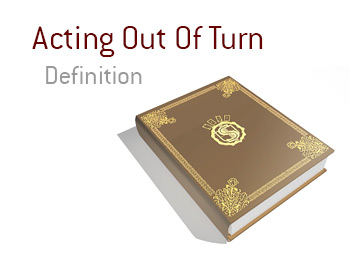Raising Out Of Turn Poker
- Raising Out Of Turn Poker Games
- Raising Out Of Turn Poker Tournaments
- Raising Out Of Turn Poker Card Game
- Raising Out Of Turn Poker Room
- Professional poker players compare the pot odds to the hand odds before calling bets on the turn and river. When pot odds exceed hand odds, a solid betting situation exists. After the flop, there is $50 in the pot. The first player raises $10.
- Acting out of turn in particularly important because it gives the players still to act behind more information than other players have had access to. Players can also put out different bet sizes to alter or influence the hand before it even gets to them. The dealer or floor person on hand will be forced to rule on which actions are binding.
- Poker Conduct 5 House Policies 6-7 Operating Procedures 8 The Buy-in/All-in /Table Stakes 8-9 Exposed Cards 9-10 Boxed Cards 10 Misdeals 10-11 Defective Deck 11 Uncalled Bet 11 Betting and Raising 11 Limit Raise Rules 12 Betting Line 12 Hand Protection 12-13 Action Out of Turn 13 Words and Gestures 13 Odd Chips 14 The Showdown 14.
In our poker math and probability lesson it was stated that when it comes to poker; “the math is essential“. Although you don’t need to be a math genius to play poker, a solid understanding of probability will serve you well and knowing the odds is what it’s all about in poker. It has also been said that in poker, there are good bets and bad bets. The game just determines who can tell the difference. That statement relates to the importance of knowing and understanding the math of the game.
Texas hold 'em (also known as Texas holdem, hold 'em, and holdem) is one of the most popular variants of the card game of poker.Two cards, known as hole cards, are dealt face down to each player, and then five community cards are dealt face up in three stages. People tend to think that the reason for this is that check-raising out of position doesn't really do much except for bloating a pot and putting you in a tough spot. The truth, however, is that check-raise is a semi-advanced play that can be very effective when done properly and MUST be a part of your arsenal.
In this lesson, we’re going to focus on drawing odds in poker and how to calculate your chances of hitting a winning hand. We’ll start with some basic math before showing you how to correctly calculate your odds. Don’t worry about any complex math – we will show you how to crunch the numbers, but we’ll also provide some simple and easy shortcuts that you can commit to memory.
Basic Math – Odds and Percentages
Odds can be expressed both “for” and “against”. Let’s use a poker example to illustrate. The odds against hitting a flush when you hold four suited cards with one card to come is expressed as approximately 4-to-1. This is a ratio, not a fraction. It doesn’t mean “a quarter”. To figure the odds for this event simply add 4 and 1 together, which makes 5. So in this example you would expect to hit your flush 1 out of every 5 times. In percentage terms this would be expressed as 20% (100 / 5).
Here are some examples:
- 2-to-1 against = 1 out of every 3 times = 33.3%
- 3-to-1 against = 1 out of every 4 times = 25%
- 4-to-1 against = 1 out of every 5 times= 20%
- 5-to-1 against = 1 out of every 6 times = 16.6%
Converting odds into a percentage:
- 3-to-1 odds: 3 + 1 = 4. Then 100 / 4 = 25%
- 4-to-1 odds: 4 + 1 = 5. Then 100 / 5 = 20%
Converting a percentage into odds:
- 25%: 100 / 25 = 4. Then 4 – 1 = 3, giving 3-to-1 odds.
- 20%: 100 / 20 = 5. Then 5 – 1 = 4, giving 4-to-1 odds.
Another method of converting percentage into odds is to divide the percentage chance when you don’t hit by the percentage when you do hit. For example, with a 20% chance of hitting (such as in a flush draw) we would do the following; 80% / 20% = 4, thus 4-to-1. Here are some other examples:
- 25% chance = 75 / 25 = 3 (thus, 3-to-1 odds).
- 30% chance = 70 / 30 = 2.33 (thus, 2.33-to-1 odds).


Some people are more comfortable working with percentages rather than odds, and vice versa. What’s most important is that you fully understand how odds work, because now we’re going to apply this knowledge of odds to the game of poker.
The right kind of practice between sessions can make a HUGE difference at the tables. That’s why this workbook has a 5-star rating on Amazon and keeps getting reviews like this one: “I don’t consider myself great at math in general, but this work is helping things sink in and I already see things more clearly while playing.”
Instant Download · Answer Key Included · Lifetime Updates
Counting Your Outs
Before you can begin to calculate your poker odds you need to know your “outs”. An out is a card which will make your hand. For example, if you are on a flush draw with four hearts in your hand, then there will be nine hearts (outs) remaining in the deck to give you a flush. Remember there are thirteen cards in a suit, so this is easily worked out; 13 – 4 = 9.
Another example would be if you hold a hand like and hit two pair on the flop of . You might already have the best hand, but there’s room for improvement and you have four ways of making a full house. Any of the following cards will help improve your hand to a full house; .
The following table provides a short list of some common outs for post-flop play. I recommend you commit these outs to memory:
Table #1 – Outs to Improve Your Hand
The next table provides a list of even more types of draws and give examples, including the specific outs needed to make your hand. Take a moment to study these examples:
Raising Out Of Turn Poker Games
Table #2 – Examples of Drawing Hands (click to enlarge)
Counting outs is a fairly straightforward process. You simply count the number of unknown cards that will improve your hand, right? Wait… there are one or two things you need to consider:
Don’t Count Outs Twice
There are 15 outs when you have both a straight and flush draw. You might be wondering why it’s 15 outs and not 17 outs, since there are 8 outs to make a straight and 9 outs for a flush (and 8 + 9 = 17). The reason is simple… in our example from table #2 the and the will make a flush and also complete a straight. These outs cannot be counted twice, so our total outs for this type of draw is 15 and not 17.
Raising Out Of Turn Poker Tournaments
Anti-Outs and Blockers
There are outs that will improve your hand but won’t help you win. For example, suppose you hold on a flop of . You’re drawing to a straight and any two or any seven will help you make it. However, the flop also contains two hearts, so if you hit the or the you will have a straight, but could be losing to a flush. So from 8 possible outs you really only have 6 good outs.
It’s generally better to err on the side of caution when assessing your possible outs. Don’t fall into the trap of assuming that all your outs will help you. Some won’t, and they should be discounted from the equation. There are good outs, no-so good outs, and anti-outs. Keep this in mind.
Calculating Your Poker Odds
Once you know how many outs you’ve got (remember to only include “good outs”), it’s time to calculate your odds. There are many ways to figure the actual odds of hitting these outs, and we’ll explain three methods. This first one does not require math, just use the handy chart below:

Table #3 – Poker Odds Chart
As you can see in the above table, if you’re holding a flush draw after the flop (9 outs) you have a 19.1% chance of hitting it on the turn or expressed in odds, you’re 4.22-to-1 against. The odds are slightly better from the turn to the river, and much better when you have both cards still to come. Indeed, with both the turn and river you have a 35% chance of making your flush, or 1.86-to-1.
We have created a printable version of the poker drawing odds chart which will load as a PDF document (in a new window). You’ll need to have Adobe Acrobat on your computer to be able to view the PDF, but this is installed on most computers by default. We recommend you print the chart and use it as a source of reference. It should come in very handy.
Doing the Math – Crunching Numbers
There are a couple of ways to do the math. One is complete and totally accurate and the other, a short cut which is close enough.
Let’s again use a flush draw as an example. The odds against hitting your flush from the flop to the river is 1.86-to-1. How do we get to this number? Let’s take a look…
With 9 hearts remaining there would be 36 combinations of getting 2 hearts and making your flush with 5 hearts. This is calculated as follows:
(9 x 8 / 2 x 1) = (72 / 2) ≈ 36.
This is the probability of 2 running hearts when you only need 1 but this has to be figured. Of the 47 unknown remaining cards, 38 of them can combine with any of the 9 remaining hearts:
9 x 38 ≈ 342.
Now we know there are 342 combinations of any non heart/heart combination. So we then add the two combinations that can make you your flush:
36 + 342 ≈ 380.
The total number of turn and river combos is 1081 which is calculated as follows:
(47 x 46 / 2 x 1) = (2162 / 2) ≈ 1081.
Now you take the 380 possible ways to make it and divide by the 1081 total possible outcomes:
380 / 1081 = 35.18518%
This number can be rounded to .352 or just .35 in decimal terms. You divide .35 into its reciprocal of .65:
0.65 / 0.35 = 1.8571428
And voila, this is how we reach 1.86. If that made you dizzy, here is the short hand method because you do not need to know it to 7 decimal points.
The Rule of Four and Two
A much easier way of calculating poker odds is the 4 and 2 method, which states you multiply your outs by 4 when you have both the turn and river to come – and with one card to go (i.e. turn to river) you would multiply your outs by 2 instead of 4.
Imagine a player goes all-in and by calling you’re guaranteed to see both the turn and river cards. If you have nine outs then it’s just a case of 9 x 4 = 36. It doesn’t match the exact odds given in the chart, but it’s accurate enough.
What about with just one card to come? Well, it’s even easier. Using our flush example, nine outs would equal 18% (9 x 2). For a straight draw, simply count the outs and multiply by two, so that’s 16% (8 x 2) – which is almost 17%. Again, it’s close enough and easy to do – you really don’t have to be a math genius.

Do you know how to maximize value when your draw DOES hit? Like…when to slowplay, when to continue betting, and if you do bet or raise – what the perfect size is? These are all things you’ll learn in CORE, and you can dive into this monster course today for just $5 down…
Conclusion

In this lesson we’ve covered a lot of ground. We haven’t mentioned the topic of pot odds yet – which is when we calculate whether or not it’s correct to call a bet based on the odds. This lesson was step one of the process, and in our pot odds lesson we’ll give some examples of how the knowledge of poker odds is applied to making crucial decisions at the poker table.
As for calculating your odds…. have faith in the tables, they are accurate and the math is correct. Memorize some of the common draws, such as knowing that a flush draw is 4-to-1 against or 20%. The reason this is easier is that it requires less work when calculating the pot odds, which we’ll get to in the next lesson.
Related Lessons
By Tom 'TIME' Leonard
Raising Out Of Turn Poker Card Game
Tom has been writing about poker since 1994 and has played across the USA for over 40 years, playing every game in almost every card room in Atlantic City, California and Las Vegas.